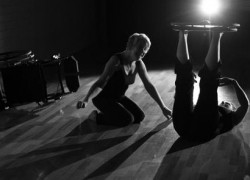
Two women, two wheelchairs, a dance studio and a projector; the combination created a startling and moving contemporary dance piece. We are trapped within our own bodies, limited by its capabilities. Some of us are lucky and are not too limited but others aren’t so lucky.
Choreographer and performer Dianne Reid, has captured the emotion perfectly; the weight and confinement of the wheel chair, literally and metaphorically. The reliance on a speech generator device, the reliance of others to help, the struggle of day to day life.
Her inspiration and duo partner Melinda Smith suffers from cerebral palsy. The mind is relatively sharp but the body, including her vocal chords, just won’t do what she wants it to do. In order to get by, she is unfortunately confined to a wheelchair and speech generator device.(Note: there are varying degrees of impairment in cerebral palsy sufferers).
So many words come to mind while watching this performance – moving, interesting, thought provoking, disturbing but in a good way. But if you’re looking for a definite description of the performance, confronting comes to mind.
The piece challenges the definition of dance; accepting someone who does not have the privilege of being able to do a great deal of movement, or having full control over their body, unlike traditional dance which generally needs controlled movement. In a voice over the ‘voice’ of Smith says “Dance has taught me to love my spasms in a strange way.”
Even though there were only two dancers, there was plenty to look at in the large space. With clever integration of shadows and projected video on the back wall, occasionally it was hard to know what to look at. They use the entire space well; Melinda crawling, Reid wheeling or dancing to the rhythmic music that were smoothly interjected by sound effects such as the sound of a pedestrian crossing traffic lights and voice over.
Reid also acted as tech, changing lights and turning projection off and on. Although noticeable from the audience, it did not detract from show.
Indeed, the performers used the entire space to their advantage, especially when Reid breaks the fourth wall by getting touchingly close to the audience. It’s awkward and risky but that’s what this performance is about, letting the audience in and in some way experience empathy for Smith and to accept her for who she is and what she can do, rather than what she can’t. Even at the start Reid is sitting amongst the audience in a wheel chair. In fact, most of the seats the audience are sitting on are wheelchairs.
It wasn’t depressing as some might assume, there were even moments of humour; one moment that stood out was when they were putting a wheel back on the wheel chair. Reid called out to Smith to hand her the wheel, a task she clearly couldn’t do. It was a moment where you could see their friendship, if a stranger had said the same thing it would have been offensive, instead it was a funny joke. This highlights how even if the body can’t move there is still a sense of humour. It is so easy to just see the wheelchair or the disease and not the person hidden behind it.
The pair have been working together since 2010, travelling around the world to perform in India and Sweden. A short film created by the duo A Beautiful Day, is also currently screening as part of the Melbourne Fringe Film program, Digital Creatures.
So go and sit in a wheel chair and be inspired for 50 minutes.

